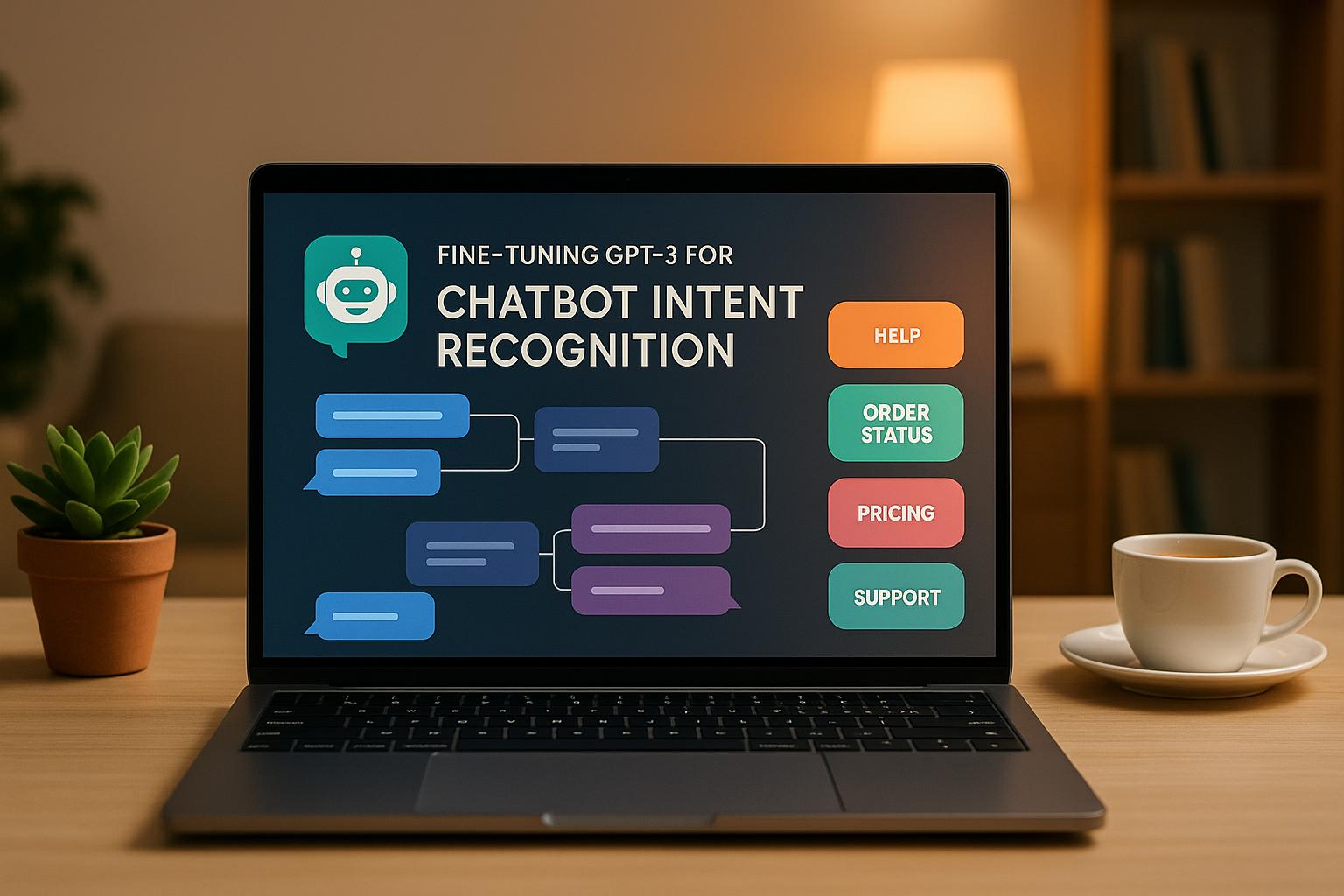Create Your Own AI Girlfriend 😈
Chat with AI Luvr's today or make your own! Receive images, audio messages, and much more! 🔥
4.5 stars

Fine-Tuning GPT-3 for Chatbot Intent Recognition
Fine-tuning GPT-3 can improve chatbot intent recognition accuracy to over 92% with just a few hundred training examples. This process optimizes GPT-3’s ability to understand user input, enabling chatbots to handle diverse queries, reduce response time, and improve user satisfaction.
Key Takeaways:
- Intent Recognition Accuracy: Boosts from 90% to 92%+ with fine-tuning.
- Data Preparation: Requires 200–300 examples minimum, JSONL format, and balanced labeling.
- Performance Gains:
- Handles 80% of routine queries without human involvement.
- Cuts operational costs by 40%.
- Privacy Measures: Includes encryption, anonymization, and access controls.
By customizing GPT-3 for specific tasks, businesses can deliver faster, more accurate, and secure chatbot interactions, driving efficiency and better user experiences.
Fine Tuning GPT-3.5-Turbo - Comprehensive Guide with Code Walkthrough
Data Preparation Steps
When it comes to fine-tuning GPT-3 for intent recognition, preparing high-quality data is a crucial step. As OpenAI points out, "The more training examples you have, the better. We recommend having at least a couple hundred examples." In fact, doubling the size of your dataset can lead to linear improvements in model performance. To fully leverage this, it's important to focus on creating well-structured datasets.
Building Training Datasets
The foundation of a great training dataset is variety. Gathering diverse conversational examples ensures the model can handle a wide range of inputs. GPT-3 requires data in JSONL format, where each entry includes prompt and completion fields.
| Data Aspect | Requirement | Impact |
|---|---|---|
| Minimum Size | 200–300 examples | Provides baseline model functionality |
| Format | JSONL structure | Necessary for GPT-3 processing |
| Quality Check | Manual review | Improves labeling accuracy |
| Data Balance | Even distribution | Reduces response bias |
"Data labeling is the activity of assigning context or meaning to data so that machine learning algorithms can learn from the labels to achieve the desired result."
To create effective datasets, consider these strategies:
- Data Augmentation: Use GPT-3's API to generate additional examples, expanding your dataset.
- Noise Integration: Incorporate varied phrasings to simulate real-world input diversity.
- Validation Process: Split your data into 70% training, 15% validation, and 15% testing to ensure balanced evaluation.
Data Labeling Guidelines
Once your dataset is ready, consistent labeling becomes essential. Proper labeling ensures the model learns accurately and performs well.
| Label Type | Purpose | Example Categories |
|---|---|---|
| Primary Intent | Core user goal | Question, Request, Complaint |
| Emotional Context | User sentiment | Neutral, Frustrated, Satisfied |
| Response Type | Expected output | Information, Action, Clarification |
Here’s how to improve labeling practices:
- Clear Category Definition: Define intent categories that reflect common user goals.
- Quality Control Process: Use expert reviews and hierarchical checks to validate labels.
- Continuous Refinement: Update labels based on real-world feedback for better accuracy.
"Labeled datasets are especially pivotal to supervised learning models, where they help a model to really process and understand the input data."
To address dataset imbalances, techniques like SMOTE (Synthetic Minority Oversampling Technique) can be applied. This ensures the model performs well across all data categories.
GPT-3 Fine-Tuning Process
Fine-tuning GPT-3 involves careful parameter selection and thorough testing to improve its ability to recognize and respond to specific intents effectively.
Setting Key Parameters
The success of fine-tuning largely depends on selecting the right hyperparameters. OpenAI provides some helpful guidelines for this process:
| Parameter | Recommended Range | Impact on Performance |
|---|---|---|
| Learning Rate | 0.02 – 0.2 | Higher rates are more effective with larger batches. |
| Batch Size | Up to 256 | Should be approximately 0.2% of the training set size. |
| Number of Epochs | 2 – 4 | Fewer epochs help reduce the risk of overfitting. |
| Base Model | ada/babbage/curie/davinci | Influences model complexity and associated costs. |
"Fine-tuning is often necessitated for domain-specific use-cases and increasing accuracy for a specific implementation in terms of jargon, industry-specific terms, company-specific products and services, etc." – Cobus Greyling
For optimization, use the AdamW optimizer with beta set to 0.9 and epsilon at 0.95. Once these parameters are configured, validate the model’s improved capabilities through structured testing.
Model Testing and Verification
Testing the fine-tuned GPT-3 requires both automated metrics and human evaluation to ensure it meets performance goals. A study conducted by Bitext in August 2023 highlights the impact of fine-tuning:
| Metric | Initial Performance | Optimized Performance |
|---|---|---|
| Accuracy | 90% | 92%+ |
| Training Data | 250 utterances | 1,000 utterances |
| Intent Categories | 27 types | 27 types |
Automated metrics, such as accuracy (53.1%), precision (59.37%), and F1 score (53.65), provide a quantitative measure of performance. However, human evaluation remains essential. For instance, native speakers can verify responses, with detection accuracy reported around 52%.
To avoid overfitting, keep a close eye on validation loss throughout the process. This is especially critical when fine-tuning for domain-specific conversations, where precision and natural language understanding are paramount. Regular monitoring ensures the model delivers accurate and contextually appropriate responses.
sbb-itb-f07c5ff
Implementation and Performance
Setting up a fine-tuned GPT-3 model for intent recognition requires a strong focus on both speed and ongoing refinement to ensure seamless interactions.
Speed and Response Time
Once the fine-tuning process is complete, the next step is to prioritize real-time performance. Even small delays can disrupt the flow of a conversation, so optimizing response times becomes essential. Here are some strategies to enhance speed and efficiency:
| Optimization Strategy | Impact | Implementation Approach |
|---|---|---|
| Async Processing | Reduces wait times | Handle multiple tasks simultaneously |
| Context Management | Cuts latency by minimizing lookup delays | Preload frequently used queries and maintain a "hot" context |
| Caching System | Saves 100–500 ms per call | Cache results and pre-defined response templates |
| Memory Optimization | Enhances processing efficiency | Separate "hot" (immediate) and "cold" (background) contexts effectively |
To further streamline performance:
- Parallel Processing: Run independent tasks at the same time to reduce overall response time.
- Smart Context Management: Prioritize "hot" context (immediate, relevant data) over "cold" context (background information) to speed up initial responses.
By focusing on these areas, you can ensure fast, fluid interactions, which are crucial for maintaining user engagement.
Model Improvement Cycle
Once the system is operational, an iterative improvement process helps refine intent recognition and maintain high performance. Key metrics to track include intent recognition accuracy, response precision, user satisfaction rates, query resolution times, and fallback occurrences.
To sustain and enhance performance:
- Track Token-Level Performance: Measure the time taken to generate each token to identify and address bottlenecks in the response pipeline.
- Implement Tiered Fallback Mechanisms: Use tiered fallback strategies to ensure the system remains responsive during performance hiccups.
- Regular Model Updates: Continuously update the model with new data to improve accuracy and adapt to changing user needs.
In addition, analyzing user interactions, conducting A/B testing, and monitoring resource use can help fine-tune the model over time. This ongoing process ensures the system remains effective and responsive to user demands.
Best Practices and Safety
Ensuring the practical deployment of GPT-3 for Luvr AI goes beyond fine-tuning - it requires a solid foundation of safety protocols. These measures are critical to protecting user data and creating secure, personalized interactions.
Data Privacy Protection
Safeguarding user privacy is central to GPT-3 interactions. A well-defined framework ensures sensitive data is protected without affecting the model's performance. Here are some key privacy measures:
| Privacy Measure | Implementation | Impact |
|---|---|---|
| Data Minimization | Collect only essential data | Reduces privacy risks and simplifies compliance requirements |
| Encryption | Use end-to-end encryption for data | Prevents unauthorized access to user conversations |
| Access Controls | Apply role-based access controls | Limits internal exposure to sensitive data |
| Anonymization | Remove personally identifiable information | Enables safe model training while protecting user privacy |
Incorporating "privacy by design" ensures data protection is built into the system from the start. As HuggingFace emphasizes:
"We endorse Privacy by Design. As such, your conversations are private to you and will not be shared with anyone, including model authors, for any purpose, including for research or model training purposes"
To enhance data security, consider these steps:
- Perform regular security audits to identify and fix vulnerabilities.
- Automate monitoring of data flows to detect and address risks in real-time.
- Define clear data retention policies, including schedules for deletion.
- Create transparent consent mechanisms for data collection and usage.
Once data privacy is secured, the next priority is ensuring the model responds appropriately to user inputs.
Managing Response Types
Effective response management is key to maintaining safe and meaningful interactions. Implementing intent detection, content filtering, and fallback protocols creates a structured approach to handling inputs. Here's how each element functions:
-
Intent Detection Systems
Analyze user input to identify problematic content and adjust responses based on sentiment analysis. -
Content Filtering Framework
Prevent the generation of harmful content, maintain conversation quality, and adapt the tone to fit the context. -
Fallback Mechanisms
Address low-confidence recognition, violations of safety parameters, and technical issues with tiered fallback strategies.
Real-time monitoring plays a critical role in fine-tuning these systems, ensuring that interaction quality remains high and boundaries are respected. For Luvr AI, these measures not only protect user data but also build and sustain trust in the platform.
Conclusion
Fine-tuning GPT-3 significantly improves chatbot intelligence and responsiveness. Data shows that fine-tuning can achieve accuracy rates exceeding 92%, even with a small number of training samples.
AI-powered customer service offers considerable benefits, including reducing operating costs by up to 40% and handling 80% of routine queries without human involvement. These advancements not only streamline operations but also enhance the overall user experience.
Key Benefits of Fine-Tuning
| Benefit | Impact | Performance Metric |
|---|---|---|
| Improved Accuracy | Better understanding of specialized language | Over 90% initial accuracy |
| Faster Response | Shorter response times | 50% reduction |
| Operational Efficiency | Automated processing of common queries | 80% of routine queries |
| Cost Savings | Lower operational expenses | 40% cost reduction |
By utilizing the extensive capabilities of pre-trained models like GPT-3, organizations can achieve exceptional performance in classification tasks with relatively minimal data and computational resources. This aligns with expert insights, emphasizing the strategic value of continuously refining these models.
The growth of intent recognition technology is poised to reshape customer service. The conversational AI market is expected to expand from $13.2 billion in 2024 to $49.9 billion by 2030. With a foundation of strong data preparation and rigorous safety measures, advancements in intent recognition are driving efficiency and affordability. For platforms like Luvr AI, these fine-tuning innovations enable secure and highly personalized user interactions.
FAQs
How does fine-tuning GPT-3 help improve chatbot intent recognition?
Fine-tuning GPT-3 allows for improved intent recognition in chatbots by training the model on datasets specifically designed to reflect the language and behavior of the target audience. This approach enables the model to better interpret and classify user inputs by learning from labeled examples that represent a range of user intents.
Through this process, the model gains a deeper understanding of domain-specific terms and subtle variations in language. This refinement is crucial for providing accurate, context-aware responses, making the chatbot more effective in managing real-time interactions with users.
How can I prepare a high-quality dataset for fine-tuning GPT-3?
To create a dataset that truly enhances GPT-3's performance during fine-tuning, start by making sure the data is varied and aligned with the tasks the model is expected to handle. Include examples that reflect your specific goals, while also addressing unusual or less common scenarios to improve the model's ability to handle a wide range of inputs.
Next, prioritize cleaning the data. This means getting rid of irrelevant or messy entries, removing duplicates, fixing errors, and ensuring formatting is consistent throughout. A well-cleaned dataset helps the model focus on learning the right patterns without unnecessary distractions.
Lastly, while having a larger dataset can sometimes boost outcomes, it's crucial to keep it structured and relevant. Focus on quality over quantity - clear, purposeful data will always yield better results than a haphazardly large dataset.
What privacy precautions should I take when using GPT-3 for chatbot interactions?
To maintain your privacy while interacting with GPT-3 chatbots, consider these important steps:
- Keep personal details private: Avoid sharing information like your name, address, or financial data.
- Secure your data with encryption: Ensure that any data transmitted is encrypted to prevent unauthorized access.
- Turn off chat history: Disabling chat history can help reduce unnecessary data storage.
- Stay on top of privacy settings: Regularly check and adjust privacy settings to match your security preferences.
- Avoid sensitive topics: Refrain from discussing confidential or highly sensitive matters to lower potential risks.
By following these measures, you can help safeguard your information and maintain a higher level of privacy when using AI chatbots.



